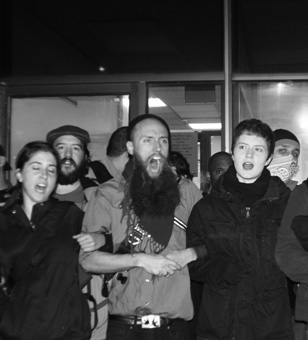In the latest of a series of small but powerful overnight occupations, activists in Chicago barricaded themselves inside Woodlawn Clinic in the Englewood neighborhood late on Thursday afternoon in protest at its closure along with five other mental health clinics. The closures are part of Mayor Rahm Emanuel’s 2012 budget, and will cut the number of mental health clinics in the city by half.
Chicago journalist Ramsin Cannon, who was on the scene, described both the occupation and its context for Gapers Block’s Mechanics blog:
Twenty Chicagoans, most of them consumers of mental health services critical to their ability to survive and function in society, have barricaded themselves in a city-run mental health clinic as a last-ditch attempt to save the facility from closure, to ensure they can keep getting the services that mean little to millions of Chicagoans but mean the world to them….
In order to cut the budget, Mayor Emanuel moved to consolidate twelve mental health clinics into six, and privatize the city’s six public health clinics. The closure of the Woodlawn facility means consumers of these services will be forced to travel longer distances, into unfamiliar neighborhoods, and seek services from unfamiliar caregivers faced now with more burdensome loads. The uninsured may face serious gaps in care.
Occupy Chicago member Kelly Hayes told Truthout: “Most of the people who barricaded themselves inside were patients, who depend on the services that these clinics provide. Other allies inside the clinic included members of Southside Together Organizing for Power (STOP), the Mental Health Movement, and a street medic from Chicago Action Medical.”
While a couple of activists who identify as Occupy Chicago members were inside the barricades, the local branch of the Occupy movement provided solidarity outside, in a similar fashion to the support given at the Piccolo Elementary and Serious Materials occupations: Tents were erected and, with the possibility of arrests for those inside threatened as early as 7 PM, occupiers sat or stood with linked arms in a mostly symbolic human blockade.
Chicago Police Department (CPD) officers initially attempted to negotiate through the barricades with those inside, as shown in this video:
However, between midnight and 1 AM, CPD and officers from the Cook County Sheriff’s Department moved in with bolt cutters, at least one hammer and other tools, and broke past the barricades. According to The Huffington Post, 23 people were arrested, 11 of whom have subsequently been released without charge.
“Watching through the window as they were arrested was heartbreaking,” said Hayes. “Some of these people are elderly, and disabled. Even with local clinics, they struggle to maintain their routines. They are brave people, just for struggling to live productive, functional lives in the face of great difficulty. And their bravery last night was inspiring.”
Another occupier, who wished to remain anonymous, said that the behavior of the police was noticeably less friendly than at previous actions involving Occupy Chicago:
They certainly were more cavalier than in previous actions and didn’t waste time with small talk. There were instances of just complete and total petty aggression, for example, I saw a police officer, far from a human barricade, give a forearm shiver to an independent journalist on the sidewalk. I heard from the other human barricade that they grabbed an older woman by the hair, and I saw them personally target women and smaller persons to bowl through to get to doors.
Kyla Bourne, a member of Occupy Chicago’s NATO Summit and May Day/Labor Working Groups, confirmed: “The police tactics were much more aggressive, especially towards those who were Livestreaming and filming.” Hayes concurred:
When the police made their way to the clinic’s glass doors, which were chained shut from the inside, the crowd locked arms and tried to stand its ground. The police got very physical with us at that point. People were shoved around pretty hard. We were fortunate that there were no serious injuries.
There were several incidents throughout the night when people were knocked down, roughed up, or otherwise physically mishandled, when no such measures were necessary. At some point, the police, particularly the county guys, just seemed to be taking out their frustration with the situation on the protesters outside.
Struggles between the police and protesters were also captured on video:
Some protesters decided to form a “human chain” blocking the exit of police vans in which arrested occupiers were being transported. Bourne explains:
We blocked police vans in order to impede the arrest of the brave and desperate people who had barricaded themselves in the clinic as a last-ditch effort to win the basic health care services they deserve. We called off the blockade when we were contacted by two organizers in the van who communicated to us that they wanted to speed up the process so that arrestees could get back to the press conference at 10am. We also heard reports that the zip-tie cuffs were too tight on some of the weaker people, and the police were refusing to loosen them.
At the press conference held on Friday morning, activists promised to continue their fight.
Join us in defending the truth before it’s too late
The future of independent journalism is uncertain, and the consequences of losing it are too grave to ignore. To ensure Truthout remains safe, strong, and free, we need to raise $44,000 in the next 6 days. Every dollar raised goes directly toward the costs of producing news you can trust.
Please give what you can — because by supporting us with a tax-deductible donation, you’re not just preserving a source of news, you’re helping to safeguard what’s left of our democracy.
